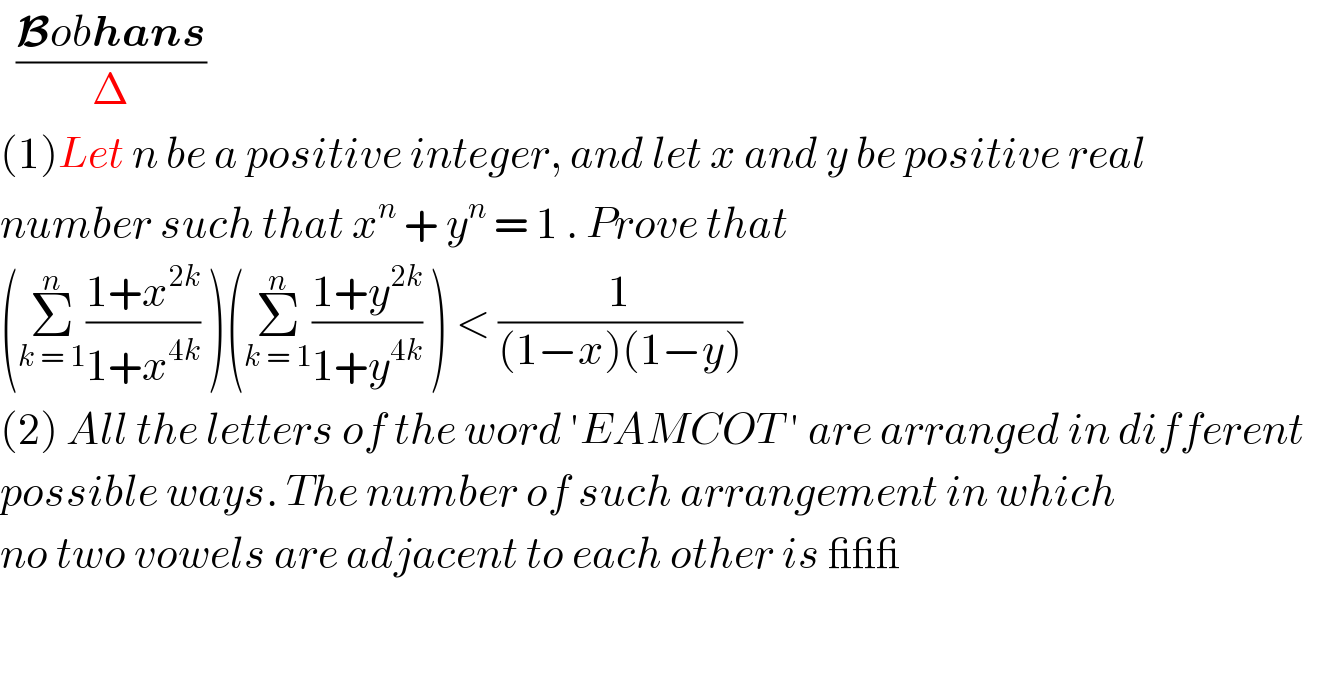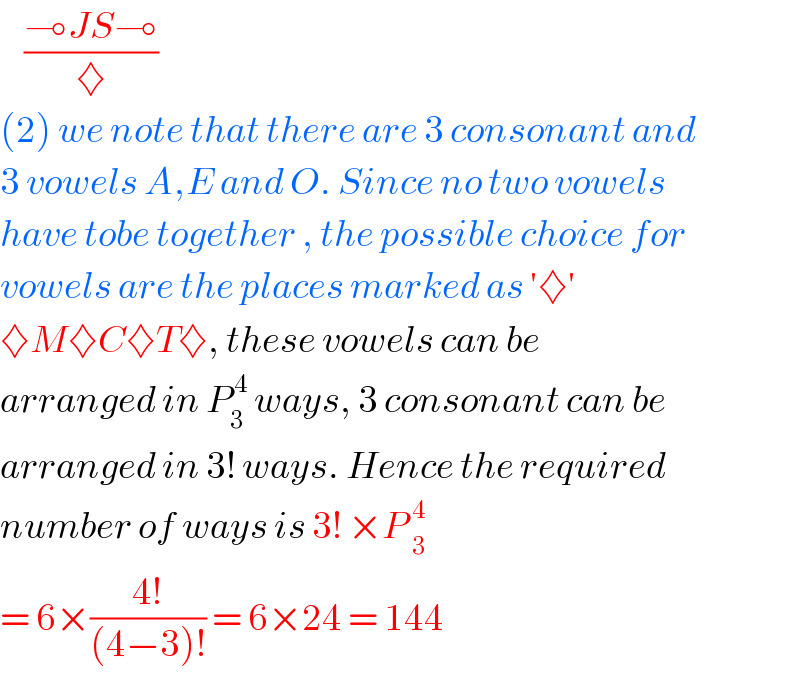
Question Number 108818 by bobhans last updated on 19/Aug/20

$$\:\:\frac{\boldsymbol{\mathcal{B}}{ob}\boldsymbol{{hans}}}{\Delta} \\ $$$$\left(\mathrm{1}\right){Let}\:{n}\:{be}\:{a}\:{positive}\:{integer},\:{and}\:{let}\:{x}\:{and}\:{y}\:{be}\:{positive}\:{real}\: \\ $$$${number}\:{such}\:{that}\:{x}^{{n}} \:+\:{y}^{{n}} \:=\:\mathrm{1}\:.\:{Prove}\:{that}\: \\ $$$$\left(\underset{{k}\:=\:\mathrm{1}} {\overset{{n}} {\sum}}\frac{\mathrm{1}+{x}^{\mathrm{2}{k}} }{\mathrm{1}+{x}^{\mathrm{4}{k}} }\:\right)\left(\underset{{k}\:=\:\mathrm{1}} {\overset{{n}} {\sum}}\frac{\mathrm{1}+{y}^{\mathrm{2}{k}} }{\mathrm{1}+{y}^{\mathrm{4}{k}} }\:\right)\:<\:\frac{\mathrm{1}}{\left(\mathrm{1}−{x}\right)\left(\mathrm{1}−{y}\right)} \\ $$$$\left(\mathrm{2}\right)\:{All}\:{the}\:{letters}\:{of}\:{the}\:{word}\:'{EAMCOT}\:'\:{are}\:{arranged}\:{in}\:{different}\:\: \\ $$$${possible}\:{ways}.\:{The}\:{number}\:{of}\:{such}\:{arrangement}\:{in}\:{which}\: \\ $$$${no}\:{two}\:{vowels}\:{are}\:{adjacent}\:{to}\:{each}\:{other}\:{is}\:\_\_\_ \\ $$
Answered by john santu last updated on 19/Aug/20

$$\:\:\:\:\frac{\multimap{JS}\multimap}{\diamondsuit} \\ $$$$\left(\mathrm{2}\right)\:{we}\:{note}\:{that}\:{there}\:{are}\:\mathrm{3}\:{consonant}\:{and} \\ $$$$\mathrm{3}\:{vowels}\:{A},{E}\:{and}\:{O}.\:{Since}\:{no}\:{two}\:{vowels}\: \\ $$$${have}\:{tobe}\:{together}\:,\:{the}\:{possible}\:{choice}\:{for}\: \\ $$$${vowels}\:{are}\:{the}\:{places}\:{marked}\:{as}\:'\diamondsuit' \\ $$$$\diamondsuit{M}\diamondsuit{C}\diamondsuit{T}\diamondsuit,\:{these}\:{vowels}\:{can}\:{be} \\ $$$${arranged}\:{in}\:{P}_{\mathrm{3}} ^{\:\mathrm{4}} \:{ways},\:\mathrm{3}\:{consonant}\:{can}\:{be}\: \\ $$$${arranged}\:{in}\:\mathrm{3}!\:{ways}.\:{Hence}\:{the}\:{required} \\ $$$${number}\:{of}\:{ways}\:{is}\:\mathrm{3}!\:×{P}\:_{\mathrm{3}} ^{\mathrm{4}} \\ $$$$=\:\mathrm{6}×\frac{\mathrm{4}!}{\left(\mathrm{4}−\mathrm{3}\right)!}\:=\:\mathrm{6}×\mathrm{24}\:=\:\mathrm{144} \\ $$
